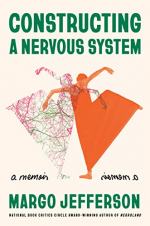|
This section contains 628 words (approx. 2 pages at 400 words per page) |

|
Constructing a Nervous System Summary & Study Guide Description
Constructing a Nervous System Summary & Study Guide includes comprehensive information and analysis to help you understand the book. This study guide contains the following sections:
This detailed literature summary also contains Topics for Discussion on Constructing a Nervous System by Margo Jefferson.
The following version of this book was used to create the guide: Jefferson, Margo. Constructing a Nervous System. Pantheon Books, 2022.
Margo Jefferson's Constructing a Nervous System marries memoir with cultural and literary criticism. At the start of the text, Jefferson explains her lifelong search for her truest self. In order to inhabit this self, she realized she would have to create a new nervous system, or identity out of fragmented component parts. Therefore, the entirety of the text is a patchwork of fragments and fractures. The text employs the first, second, and third person points of view, as well as the past and the present tenses. The following summary attempts a more streamlined mode of explanation.
In Chapter I, Jefferson describes the ways in which she has regarded herself over the years. For a long time, Jefferson believed that in order to become the best version of herself, she had to chop away the ugly and unworthy facets of her character. This work eventually proved tiring and unsatisfying. She began to realize that her truest self was neither neat nor perfect. Rather, her essential self is an amalgam of words, thoughts, memories, reflections, influences, and experiences. She therefore sets out to represent her curation of this self on the page.
In Chapter II, Jefferson remembers listening to jazz musician Bud Powell's Jazz Originals record as a young girl. She particularly liked to put the album on when she was by herself. She liked to imagine what Powell looked like while performing. When she recalls her father Ronald telling her about Powell, Jefferson wonders at what moved Ronald about Powell. She realizes that in the same way Powell used music to free himself and rescue others, Ronald used medicine to free himself and rescue others.
Unwilling to dwell on the traumas of her childhood, Jefferson decides to reflect on Ella Fitzgerald's life. She considers the ways in which Fitzgerald reinvented her childhood suffering in the service of her work.
In Chapter III, Jefferson recalls the first time she and her sister Denise read Gone with the Wind. Not long after seeing the film adaptation, Hattie McDaniel won an Oscar for her role as Mammy in the movie. Although McDaniel was inspiring and Mammy was fearless, Jefferson was reluctant to see either of them as role models. Because of the lack of black female representation in the media, they had trouble finding individuals through whom they could understand themselves.
In Chapter IV, Jefferson describes her experience reading Uncle Tom's Cabin for the first time. Contrary to her expectations, the book ended up freeing Jefferson in personal and literary ways. She became obsessed with Stowe's characters Tom and Topsy.
In Chapter V, Jefferson decides that after years of reading and teaching Willa Cather's The Song of the Lark, she must interrogate the novel. Although she reveres Cather, she acknowledges her insufficient or banal representations of black lives in her work.
In Chapter VI, after Jefferson breaks up with her lover, she revisits Measure for Measure, finding fodder for her thoughts about virginity versus chastity. She goes on to consider the ways in which various musical and literary women inspired and influenced her throughout her coming of age.
In Chapter VII, Jefferson reflects on the life and work of Josephine Baker, a singer, performer, activist, and World War II spy. Baker is one of those cultural figures whose influence and contributions continue to inspire and astound Jefferson.
In Chapter VIII, Jefferson recalls several feminist meetings she attended during the feminist movement in the 1970s. Revisiting one such meeting inspires her reflections on fatigue and the grandmother figure in black narratives. She realizes that if her grandmother were still alive, she would tell her she has yet to earn her fatigue.
Read more from the Study Guide
|
This section contains 628 words (approx. 2 pages at 400 words per page) |

|



